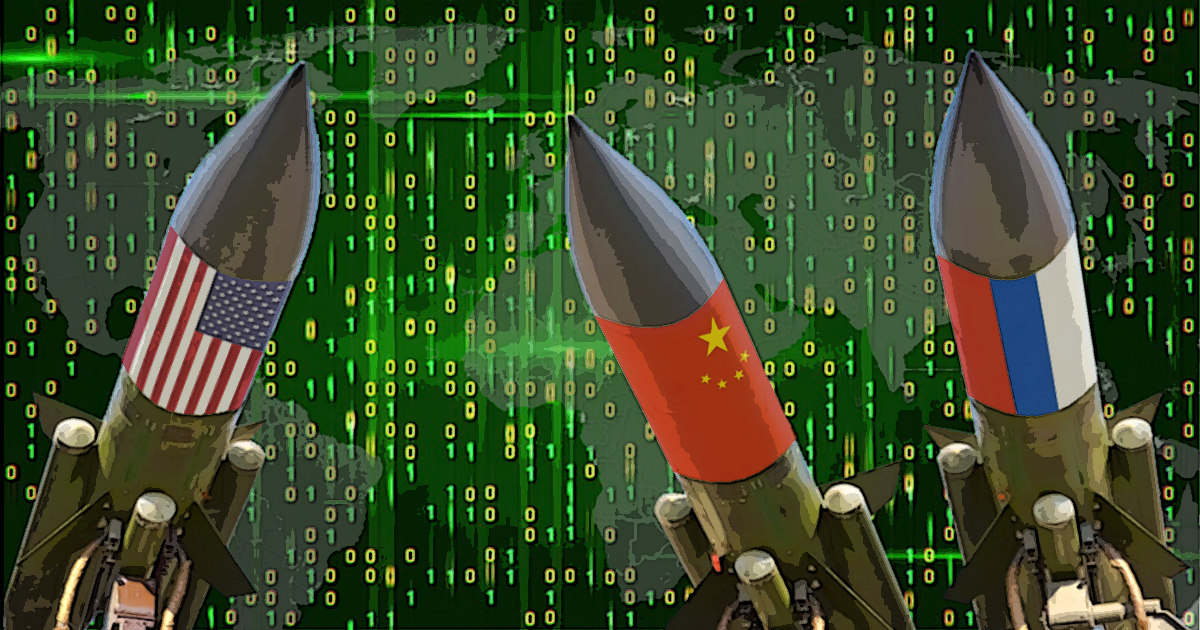Nathan Gardels is the editor-in-chief of Noema Magazine.
The Trump administration’s new National Defense Strategy, recently announced by Defense Secretary James Mattis, signals the return to a global arms race and “great power” competition between the U.S. and its now officially named strategic rivals — Russia and China. “Inter-state strategic competition, not terrorism, is now the primary concern in U.S. national security,” according to the strategy document which outlines the military dimension of the president’s “America First” posture. “For decades, the United States has enjoyed uncontested or dominant superiority in every operating domain,” the strategy reads. “Today, every domain is contested — air, land, sea, space and cyberspace.”
To keep the peace, a balance of power among strategic rivals is a wise objective for any nation. But unless partnership on matters of mutual interest, for example climate change or nuclear non-proliferation, is an integral part of calculating that balance, a metric of military might alone tends toward the risk of war — each side will seek advantage over the other in the name of defense. If there is no sense of common intent on any front, all else dwells in the dark shadow of distrust.
At least rhetorically, Chinese President Xi Jinping has charted an approach that is diametrically opposed to the new U.S. doctrine by recognizing that the reality of interdependence must temper outright rivalry. China under Xi’s leadership has taken the lead on climate change and called for a “new type of great power relationship” that embraces “a community of common destiny.”
To be sure, how these fine words square with the reality of China’s unilateral forays into the South China Sea or its mercantilist trade practices raises a cynical eyebrow. China’s claim that its new Silk Road infrastructure investment initiative across Eurasia is an open platform to provide global public goods is also subject to question, since nearly 90 percent of the contracts so far are with Chinese companies.
Nonetheless, the announcement of a new U.S. doctrine so contrary to China’s officially articulated worldview sets the stage for a grand contest over the shape of the next world order.
Or does it? Salvatore Babones is skeptical both of China’s “common destiny” claims and that it really presents a strategic challenge to the U.S. “Xi has embraced his scripted role as the leader of a new, China-led world order,” he writes from Sydney, Australia.
“His ‘Chinese dream’ for the ‘great renewal of the Chinese nation’ is a 21st century vision of multilateral cooperation wedded to the very 20th century notion of nationalist militarism. At the heart of ‘Xi Jinping Thought’ is the assumption that in a world of great power rivalry, China is the great power that will win. The problem for Xi — and for his program — is that great power rivalry stubbornly refuses to materialize. Chinese people would rather go to school in the U.S. than invade it.”
For Babones, “the proposition that China has the potential to create a new world order centered on itself is predicated on the assumption that it will continue its rapid growth for another generation or two. As heroic as that assumption may be, it is not nearly so heroic as the deeper assumption that China’s next generation will share the Cold War mentality of their parents. If Chinese millennials are anything like American ones, they are likely to value access to the App Store more than ambitions of geopolitical domination. And if that is the case, the world has little to fear from a China-centered world order, now or in the future.”
Fyodor Lukyanov weighs in from the perspective of America’s other nominal strategic rival, Russia. “The liberal world order discourse — a positive-sum game which honors interdependence instead of competition, economy above security — has never been taken seriously in Moscow,” he writes from the Russian capital. “The ‘balance of power’ idea, the basic realpolitik notion, appears several times in the new U.S. defense strategy. In Russia, it has always been part of the nation’s political thinking and rhetoric, while the West at some point started to view it as an anachronism. Now Russia and the U.S. are once again using the same conceptual language.” At least on this score, there is an objective collusion between the Trump administration and Russian President Vladimir Putin.
As Lukyanov sees it, being on the same page of strategic rivalry inevitably entails an accelerated arms race. “The emphasis placed by the U.S. strategy on technological advancement will allow Russian generals to demand more funding for similar purposes. … Russian-American relations have returned to the Cold War model: military competition, a potential arms race and deterrence.”
Yet, Lukyanov continues with a nod to both China’s arrival on the scene and the permeable borders of cyberspace: “The clash between Moscow and Washington is not central to the international system, which is polycentric, chaotic and diverse. A common conceptual outlook … cannot revive the mechanisms of ensuring global stability that worked 40 years ago. Cold War-era recipes will no longer be effective — there are too many other actors who do not listen to either Russia or America.”
“Splinternet” author Scott Malcomson hones in on the critical new element of instability in any future arms race. “The major nuclear powers, who are also the major cyber powers, are currently growing their nuclear arsenals at both strategic and tactical levels and are each captivated by fear of what the others might be doing,” he writes. “These arsenals are increasingly cyber-dependent — protecting and controlling them requires ever more sophisticated electronic networks — and this dependence creates vulnerabilities, heightening the likelihood of infiltration and distrust. Yet confidence is key to nuclear stability: confidence in opponents’ control over their own weapons and confidence in your own. That confidence is being undermined by cyber, and it is hard to see how it can be rebuilt without strategic cyber negotiations.”
Taking a cue from the Reagan years, when heightened tensions between the U.S. and Russia in the end yielded to arms reduction treaties, Malcomson argues that the new dangers today spelled out in the National Defense Strategy might just, paradoxically, be the opportune environment to tackle cyber and nuclear threats before they get out of hand.
This was produced by The WorldPost, a partnership of the Berggruen Institute and The Washington Post.




